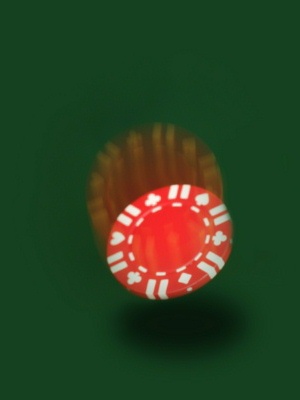|
|

Ante – A small amount of money used to seed the pot. Often used in the late stages of tournament play, or in ring games where blinds are
not present.
Used primarily in Stud games, antes are used as a way to seed the pot.
Antes and blinds function differently, but both have the common purpose of seeding the pot prior to the initial dealing of the hand. In
most ring games,
blinds are used in flop and draw games, while antes are
commonly used in stud games.
Let’s take a moment to describe the difference between blind and antes. Blinds are used instead of antes for virtually all flop and draw
games, however there are situations in these games (especially in tournaments) where antes may be used in addition to blinds. Blinds are
forced (mandatory) bets made before the cards are dealt. Blind positions and amounts are inflexible and are determined by the rules of
the game and/or the house rules. They are usually posted to the immediate left of the dealer button, and are sometimes posted on the
button as well. Technically, if stipulated by the rules, blinds could be posted from anywhere.
A blind is really a blind call (or partial call). This means that when you post a blind prior to the initial deal, the amount you have
posted is credited toward the amount required to call, after the initial deal. So blinds seed the pot prior to the initial deal, and
receive credit towards a call afterwards. This is not the case with antes. It is required that antes be posted prior to the initial
deal, by every player who wishes to be dealt in. This money is used to seed the pot, but that is it. Players receive no future credit
for paying their antes.
In addition to their role of seeding the pot in Stud cash games, antes are often used in addition to blinds, in the later stages of
non-stud tournaments. Typically, in the early rounds of these tournaments, antes are not used. They are introduced in the later stages,
with the purpose of tweaking the action. Let me explain.
Tournaments are, among other things, an exercise in
maximizing profit while moderating risk. If you are reckless and assume too much risk in tournament play, you will not have much success
in the long run. However, if you are too conservative, and don’t take enough risks, you will not maximize profit, and may have a very
hard time acquiring chips. This means that players will try to find the right level of risk in the middle ground, by sometimes taking
risk when it is appropriate and sometimes backing off.
One major factor affecting the correct level of risk you should assume is the amount of time you have to find a highly advantageous
spot. This is dictated by the cost per round (in blinds and/or antes) and its ratio to the size of your stack. For example, a player
whose stack size is 25 times the cost per round will have substantially more time to make a hand than a player with only 5 times the
cost per round. Obviously, the player with only 5 times the cost per round has much less time to find a good spot, and therefore must
assume more risk to be effective. So the cost per round, and its proportional relationship to your stack size, has a profound effect on
your incentive to take risk. This brings us to the main reason antes are often added in addition to blinds in the later stages of
non-stud tournaments.
In the early stages of these tournaments, there are only blinds. Players can calculate their cost per round by simply adding up their
blind commitments. These commitments start out relatively small compared to the amount of starting chips. Since the cost per round is
small compared to stack size at this point, there is little incentive to take unnecessary risk. The incentive here is to play tight and
wait for a dominant situation where you can increase stack size without a lot of risk. This dynamic holds as long as the cost per round
does not threaten your stack. It can also make for not much action from the field in the later rounds of the tournament. Additionally,
as the money positions approach, play gets even tighter Antes are used as a way to loosen things up.
Consider the impact of introducing antes in addition to blinds in the later rounds of a non-stud tournament. Prior to the addition of
antes, cost per round was calculated by adding up your blind commitments, which would typically be paid in two installments (small blind
and big blind). When the antes are added, the costs per round increase significantly. All players must now pay the two installments,
plus an additional ante on every hand. This means that not only is your stack eroded more quickly and more frequently, but there is also
more money in every pot before the flop. This increases the incentive to take risk in two major ways. First, your stack is being eroded
faster, leaving you less time to find a dominant spot. This makes building your stack a more pressing task. Second, including antes now
makes every pot larger, and a bigger reward justifies taking on more risk. It becomes correct to “go for” more pots.
So antes can be used in the later stages of non-stud tournaments to “correct” a natural bottleneck in the action. They incentivize more
aggressive play over tight play. Players are aware of this and consciously change their style of play once the antes have been added.
This is called “switching gears.”
Usage: Ante-Up, Steal the Antes, Blinds and Antes
Previous Poker Term: Angle
Next Poker Term: Backdoor
|
|









